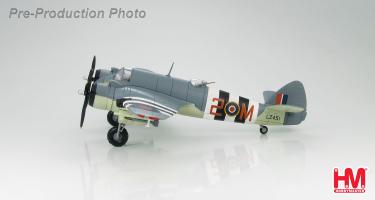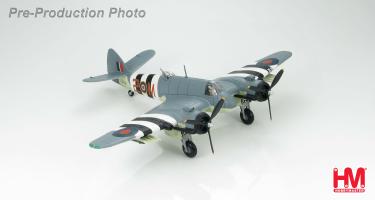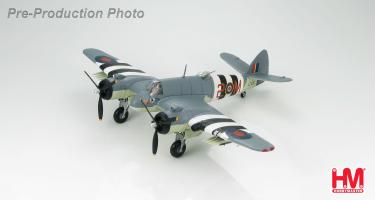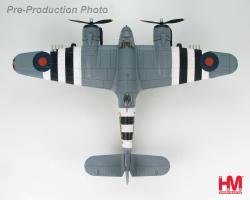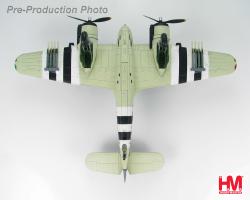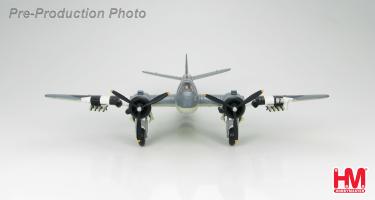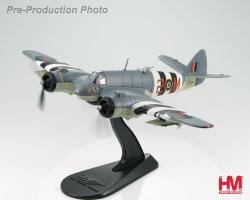Hobby Master Archive
Air Power Propellers 1/72
Beaufighter
Bristol Beaufighter TF.X LZ451, 404 Sqn. RCAF, RAF Coastal Command, Davidstow Moor, June 1944
The Bristol Beaufighter was designed as a two-seat long-range fighter. To speed up production many parts of the older Bristol Beaufort were used. The tail, landing gear and wings of the Beaufort were transplanted to the Beaufighter and most units were equipped with airborne radar located in the nose for night-fighting. The Mk. IF was the initial production and fitted with four 20 mm cannons in the nose along with six 7.7 mm machine guns in the wings. The Beaufighter TF Mk.X was the last major version with 2,231 built.
The RCAF 404 Squadron was known as the “Buffalo Squadron”. In June 1944 the squadron was part of RAF Coastal Command stationed at Davidstow Moor, in North Cornwall. On June 4, 1944 the aircraft received their D-Day invasion stripes. On June 6, 1944 three German Narvik Class destroyers were sighted proceeding up the English Channel towards the D-Day landing. Fourteen Beaufighters from 404 were sent to intercept the ships. Armed with 25-pound SAP (semi-armor piercing) RP (Rocket Projectiles) they found their targets and attacked the lead ship and then the second. Both were left on fire while the third ship used ship number 2 as cover. All aircraft returned to base to refuel and rearm for a second strike. The ships were located again and with two of them smoking the third ship was the main target. It too was set afire but as it turns out the three ships managed to limp back to port and within two days they were back in the English Channel. It was later determined that 74 of the 96 RP’s found their targets. This time they encountered the 10th Destroyer Flotilla that destroyed one ship, drove another onto the rocks and forced the third back to Brest. RCAF 404 Squadron received their Beaufighters in September 1942 and never flew against ground targets and never carried anything but RP’s. In April 1945 404 Squadron switched to Mosquitos. LZ451 2-M (2 signifying Davidstow Moor) was crewed by F/L WR Christison from Lennoxville, Quebec and F/L Toon.
Specifications: Bristol Beaufighter T.F.X Dimensions Wing span - 57 ft. 10 in. (17.64 m) Length - 41 ft. 4 in. (12.59 m) Height - 15 ft. 10 in. (4.84 m)
Weight Empty - 15,592 lb (7,072 kg) Maximum - 25,400 lb. (11,521 kg) Disposable Load - 9,808 lb. (4,448 kg)
Performance Powerplant - 2 x Bristol Hercules XVII fourteen-cylinder two-row sleeve-valve radial engines rated @ 1,725 hp (1,286 kw) @ 2,900 rpm for take-off rated @ 1,395 hp (1,040 kw) @ 2,400 rpm at 1,500 ft. (457 m) Maximum Speed - @ sea-level - 320 mph (514 km/h) Service Ceiling - 19,000 ft. (5,791 m) (without torpedo) Range with torpedo and normal fuel - 1,400 miles (2,253 km) with torpedo and long-range tanks - 1,750 miles (2,816 km)
Armament 4 x 20-mm. Hispano cannon in the fuselage nose 6 x 0.303-in. machine-guns in the wings 1 x 0.303-in Vickers “K” or 1 x Browning gun in the dorsal position 1 x 18-in. torpedo under fuselage 8 x rocket projectiles instead of wing guns.
Hobby Master 1/72 Air Power Series HA2309 Bristol Beaufighter TF.X LZ451, 404 Sqn. RCAF, RAF Coastal Command Davidstow Moor, June 1944
Die-cast metal. Superb detailing in 1/72 scale. Pre-painted with pad applied markings. Fully assembled. Weapons that are not permanently attached. Comes with crew figures Display stand included. Option to display model with wheels up or down. Movable propellers. Minimum use of plastic.
| Added to archive | 2015-11-19 |
| Last modified | 2015-11-19 |
| Leaflet | 2010-11-01 November 2010 |

